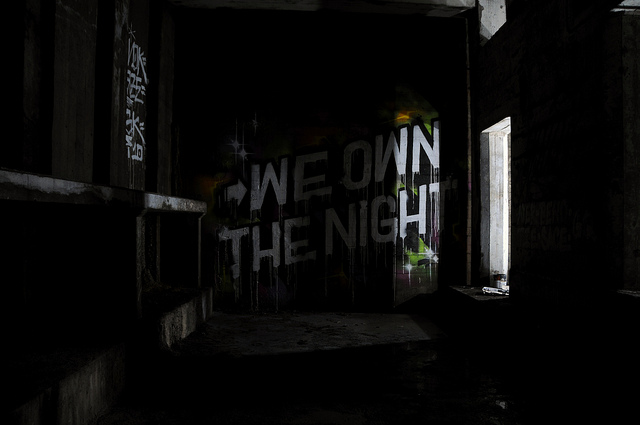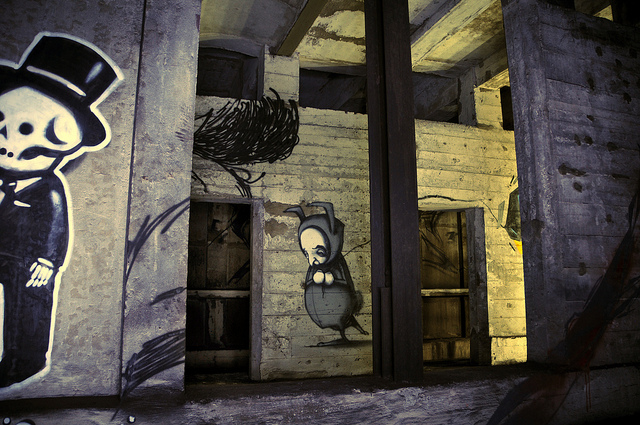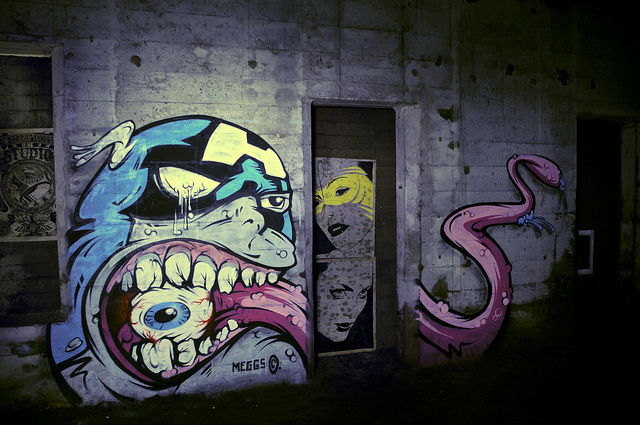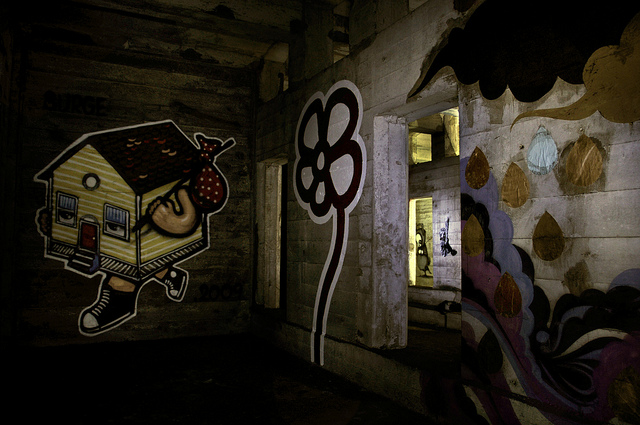
Originally, I submitted this essay for publication in the We Own the Night, the official book of The Underbelly Project. It was not published in the book, but today, the two-year anniversary of the public announcement of The Underbelly Project, seems like a good time to finally get this piece out into the world. – RJ
There’s a certain group of street artists, a group whom I tend to admire, who make art to give a gift to the rest of the world. These artists create spectacles. These artists attempt to make the world a better place by putting their art into it. These artists increase the amount of wonder in our everyday lives. This group includes artists like Swoon, Mark Jenkins and the performers in Improv Everywhere.
While not all street artists are trying to do what Swoon and Mark Jenkins are doing, there’s certainly an element of that in the vast majority of street art. At the very least, interacting with society in some way seems to be so much of what street art is about. Like Banksy said “even if you don’t come up with a picture to cure world poverty, you can make somebody smile while they’re having a piss.”
So what does that mean for The Underbelly Project? If I’ve just described the most pure and ethical goal of street art, The Underbelly Project fails miserably. It is inaccessible to the public and will remain so for the foreseeable future. Only a few people besides the artists themselves ever saw any of the project in the flesh, and most of the artists did not have a chance to wander around the space and experience see more than just their wall. And yet, this is not something I even considered during my visit to The Underbelly Project. The idea that The Underbelly Project might be failure as street art is something I only really considered after the project went public and people were disappointed that they had not seen it in the flesh. Why did I experience that disconnect? Is it simply that I was one of the few non-artists to see the station in-progress, so I am speaking from a privileged position? Maybe, but I didn’t go down to The Underbelly Project’s installation in Paris and I still enjoy those photos.

Yes, it could be argued that The Underbelly Project, as a street art project, failed very clearly. But I don’t think that’s the case.
First of all, street art in this decade is, for better or worse, mostly viewed online or in books. Yes, I experienced The Underbelly Project in person and it was a unique and unforgettable experience, but that was an experience of the space more than an experience of the art. To fully appreciate the art, I had to look at photographs. Cameras depict the station better than the human eye possibly could in that darkness. As valuable an experience as it was to get down into The Underbelly Project and wander around, there’s just as much value, in a different way, in looking at good photographs of it.
Maybe the angle of Underbelly as a “street art” project is all wrong. The Underbelly Project is not really a street art project or a mural project. Workhorse and PAC know how to organize mural projects. They know what large street art mural projects look like: lots of artists painting in daylight in very public spaces, usually over the course of a few days, and interacting with curious members of the public. The Underbelly Project is something else. If it’s something else, it should be held to a different (but not necessarily higher or lower) standard.
The Underbelly Project should be compared to the work of the street artists and graffiti writers who paint in abandoned factories. Very few people will ever see those murals in the flesh, but that does not make them any less impressive. Murals in abandoned factories are not gifts to the world in the same way that it is a gift when Swoon commands a flotilla down the Mississippi, but there’s still something valuable about them.

Aren’t artists allowed to enjoy themselves? It is selfish on the part of fans to say that street artists can only paint outdoors in spaces where lots of people will see the work. The Underbelly Project, like murals in abandoned spaces, was a space for artists to experiment and be free. That’s where the project was an astounding success: In a culture where artists are constantly under pressure to perform and sell and promote, The Underbelly Project stripped all that away and brought the artists back to making art for the sake of making art, which is just as much a part of the street art spirit as giving gifts to the public. Street art is about anybody being able to make art and just getting out and doing it for the love of making, rather than for the sake of a paycheck.
Going into The Underbelly Project, it seems that artists didn’t know if their contributions would ever be seen, how images might be distributed, who else was involved or if spending a night painting would “pay off” in a monetary sense. When I accepted the invitation to go see the project, about all I was really told was that I should get to NYC at a certain time of year because it would be worth my while and I’d see something cool. I learned a little bit more about what I was in for before going down, but not much. I thought it would be fun or terrible or interesting or, at least, memorable. I would have accepted the invitation even if I had been forever sworn to secrecy about the existence of the project.

The Underbelly Project is not a gift to the public; it is something for the artists.
Of course, The Underbelly Project will not remain inaccessible forever. People made it into the station for a few days after news of the project broke, but then it sounds like the MTA sealed off the entrance more thoroughly. Some day though, that entrance will be unsealed. Maybe it already has been. Some day, daredevils will risk their safety to visit the station. Maybe they will know about The Underbelly Project or maybe they won’t. Maybe some of the artwork will still be intact or maybe it will all be destroyed. Whatever the case may be, at that point, The Underbelly Project will be a gift. Not to the rest of a world, but to a select few.
Photos by RJ Rushmore
